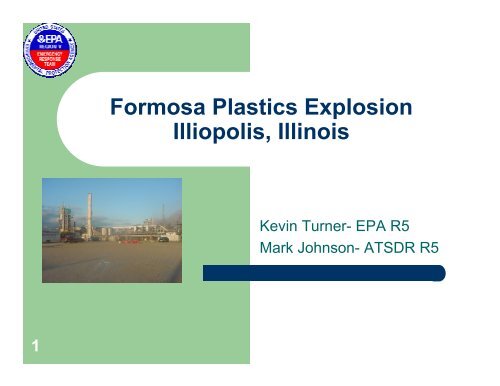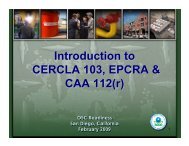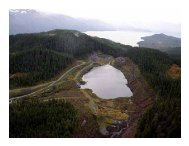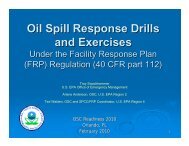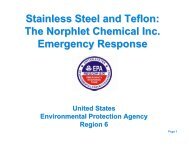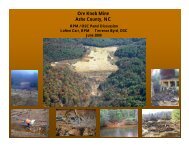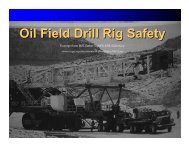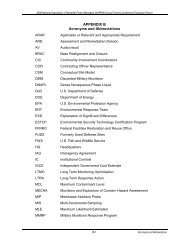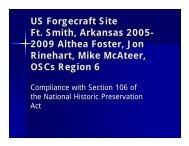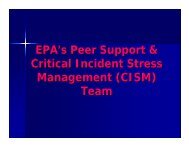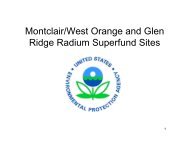Formosa Plastics Explosion Illiopolis, Illinois
Formosa Plastics Explosion Illiopolis, Illinois
Formosa Plastics Explosion Illiopolis, Illinois
Create successful ePaper yourself
Turn your PDF publications into a flip-book with our unique Google optimized e-Paper software.
<strong>Formosa</strong> <strong>Plastics</strong> <strong>Explosion</strong><br />
<strong>Illiopolis</strong>, <strong>Illinois</strong><br />
Kevin Turner- EPA R5<br />
Mark Johnson- ATSDR R5<br />
1
Objectives of Case Study presentation<br />
• Summarize the site decisions<br />
• Identification of chemicals of concern<br />
• Development of action levels<br />
– Evacuation<br />
– Relocation of residents<br />
– Reopening of schools<br />
2
<strong>Formosa</strong> <strong>Plastics</strong> Company<br />
• Located in <strong>Illiopolis</strong>, IL; 20 miles east of Springfield<br />
• <strong>Formosa</strong> <strong>Plastics</strong> Company manufacturer<br />
polyvinylchloride (PVC) resin for plastic manufacture<br />
• About 2 million lbs of granular PVC resin stored in<br />
paper bags on-site<br />
• 150,000 gallons of vinyl chloride present on site in<br />
refrigerated storage vessels<br />
• 4 radiation sources on-site<br />
3
<strong>Formosa</strong> <strong>Plastics</strong> explosion<br />
• <strong>Explosion</strong> occurred on Friday<br />
(11-23-04) at 2200 hrs<br />
• 50-75% of the plant was<br />
demolished by the explosion<br />
• impact of the explosion was<br />
felt at least 60 miles away<br />
from the facility<br />
• Cause of explosion related to<br />
mixing of vinyl chloride and<br />
vinyl acetate<br />
4
Impact of explosion<br />
5<br />
• 18 workers at plant<br />
• 4 workers died immediately at time of<br />
explosion; 1 worker died a month later<br />
• PID readings in body bags were >200 ppm<br />
• 2 other workers were severely burned; 2<br />
firefighters sustained chemical injuries during<br />
the response<br />
• ½ mile initial evacuation zone; later<br />
expanded to 1 mile
Agencies in response<br />
• Springfield Fire Department<br />
• IL EPA<br />
• IL Dept. of Public Health<br />
• USEPA/START<br />
• ATSDR<br />
• National Chemical Safety Board<br />
• Center for Toxicology and Environmental Health<br />
• <strong>Formosa</strong> <strong>Plastics</strong> contractors<br />
• Local fire department estimated that 265 rescue<br />
workers from 28 agencies responded to the incident.<br />
8
EPA Emergency Response<br />
• EPA OSCs Ken Rhames and Kevin Turner<br />
responded<br />
• National Response Center called Saturday<br />
(2100 hrs)<br />
• ATSDR-R5 (Mark Johnson) contacted<br />
Sunday at 0200 hrs<br />
9
U.S. EPA Actions Taken<br />
• Verbally notified the <strong>Formosa</strong> <strong>Plastics</strong> Company under<br />
CERCLA authority to hire fire fighting, environmental, and<br />
demolition experts to completely extinguish the fire, contain and<br />
treat fire fighting water, collect and analyze air and water<br />
samples and begin clean-up and demolition.<br />
• Requested that a Unified Command structure be established .<br />
• Conducted perimeter and residential air monitoring<br />
• Conducted oversight of PRP contractors, while they conducted<br />
air monitoring and sampling activities.<br />
10
Roles of Responders<br />
Environmental Response<br />
• U.S. EPA<br />
– (Perimeter and Residential<br />
Ambient Air Monitoring)<br />
- ATSDR<br />
- WESTON<br />
• IEPA<br />
– Sampling and Monitoring<br />
Run-off Water, Creek and<br />
Sangamon River<br />
11
N<br />
Interstate<br />
72<br />
Area of explosion<br />
Vinyl chloride<br />
tanks<br />
12<br />
<strong>Illiopolis</strong>
Contaminants of Concern<br />
• Volatile Organic Compounds<br />
(VOC)<br />
• Carbon Monoxide<br />
• Particulates<br />
• Vinyl Chloride<br />
• Hydrochloric Acid<br />
• Phosgene<br />
• Mercury<br />
• Asbestos<br />
• Radiation<br />
• Dioxins<br />
13
Environmental conditions<br />
• Wind direction at the time of the explosions was out<br />
of the north.<br />
• As the fire burned winds shifted and came out of the<br />
west.<br />
• Area residents were evacuated (½ mile radius)<br />
• 20-mile section of Interstate 72 was closed for about<br />
6 hours<br />
14
15<br />
What questions should you be asking
Toxicity for Chemicals of Concern<br />
• Hydrochloric acid<br />
• Phosgene<br />
• Vinyl chloride<br />
16
Alveoli
Hydrochloric acid (HCL)<br />
• Action level: 2 ppm; based on acute health effects<br />
• Corrosive irritant at site of contact- eyes, skin, mucous<br />
membranes of mouth, throat, and esophagus<br />
• Inhalation at irritating concentrations causes coughing, pain,<br />
inflammation, and edema of the upper respiratory tract<br />
• To reach the lung, it must be transported either as an aerosol or<br />
as a deposit on soot particles of less than 3 um in diameter<br />
• Particulates in smoke from incineration of chlorinated polymers<br />
can transport HCl gas to the lung<br />
18
Cl<br />
Phosgene<br />
O<br />
C<br />
Cl<br />
19<br />
• Action level: 1 ppb; based on acute health effects<br />
• Colorless oxidant gas; heavier than air<br />
• Generated from oxidation of chlorinated organics<br />
• Breaks down to HCl and carbon dioxide<br />
• Phase 1- pain in the eyes and throat and tightness in the chest,<br />
shortness of breath, wheezing, and coughing<br />
• Phase 2- latent phase, without symptoms; can last as long as 24 hr<br />
• Phase 3- Pathological changes in lower respiratory tract at low<br />
concentrations; pulmonary edema may develop at high<br />
concentrations
Vinyl chloride<br />
• Action level: 0.5 ppm; based on prolonged<br />
exposure (several days)<br />
• Critical effect: impact on fetal developmental<br />
from acute exposure during pregnancy<br />
• Low acute toxicity<br />
• Known human carcinogen<br />
• High vapor density<br />
20
Air Monitoring Instruments<br />
• Multi Rae and AreaRAE:<br />
-PID, O 2 , CO, H 2 S, LEL<br />
• Micro-R: radiation (gamma)<br />
• Mini RAM: particulates<br />
• Lumex: mercury<br />
• GC spectroscopy<br />
- Calibrated to 2 ppb VC<br />
• Single Point Monitor<br />
- HCl<br />
-Phosgene<br />
• Drager Tubes<br />
-VC<br />
- HCl<br />
-Phosgene<br />
21
Monitoring Results<br />
• Particulates: 45 mg/m 3 (Data RAM), which is above<br />
health standards (2.5mg/m 3 )<br />
• Hydrochloric Acid: 4 ppm (GC); nd (Draeger)<br />
• Phosgene: 0.1 ppm (GC;1 detect); nd (Draeger))<br />
• Vinyl Chloride: 0.3 ppm (GC); nd (Draeger)<br />
• VOC levels: 2.7 ppm<br />
• Radiation levels: below background (5 uR/hr) off-site<br />
• Springfield Haz-Mat detected radiation inside the<br />
facility at 40 uR/hr<br />
23
Response Worker protection<br />
• PPE for removal of smoldering source<br />
material inside building<br />
24
25<br />
What do you want to know about<br />
residual contamination
Clearance of homes and schools<br />
• PID walk-through of<br />
homes to allow for<br />
relocation<br />
• PID walk-through of<br />
schools to authorize reopening<br />
26
Residential Soil Sampling<br />
• SVOCs<br />
– no exceedances of health-based criteria<br />
• Dioxins: by-product of PVC combustion<br />
– highest level in residential property: 50 ppt<br />
– highest level on-site: 66 ppt<br />
– Superfund evaluation criteria for residential soil:<br />
1,000 ppt<br />
27
Follow-up medical evaluation of<br />
emergency responders and residents<br />
• Urine testing for vinyl chloride exposure<br />
provided to 311 people<br />
– No significant exposures<br />
• Liver function tests provided to 65 people<br />
– No abnormal results<br />
28


